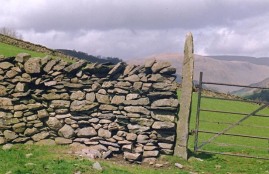Is a wall and a wall,
Leaning together
(Cumberland and Westmorland
Champion wrestlers)”
so says Norman Nicholson.
What a wonderful image! For the walls here are often made up of two separate walls enclosing a centre filled with small stones called “heartings”. The construction has long “through” stones to tie the two outer walls together and is finished off with a final top course of thinner slab-like stones on top of which the “cams” or coping stones were placed.
And Cumberland Wrestling is a traditional sport you can often still see at the Summer Shows including our own Broughton & Millom Show.  The origin of this style of wrestling is a matter of debate, with some describing it as having evolved from Norse wrestling; others associate it with a Celtic tradition. It’s great fun to watch and as they start, gripping each other around the backs, it is easy to see why it reminded Nicholson of the Lake District walls which are some of the most distinctive and most loved features of the fells.
The origin of this style of wrestling is a matter of debate, with some describing it as having evolved from Norse wrestling; others associate it with a Celtic tradition. It’s great fun to watch and as they start, gripping each other around the backs, it is easy to see why it reminded Nicholson of the Lake District walls which are some of the most distinctive and most loved features of the fells.
“The wall walks the fell –
Grey millipede on slow
Stone hooves;”
Quotations taken from Norman Nicholson’s “Wall” in his 1981 collection “Sea to the West”. © The Trustees of the Estate of Norman Nicholson, by permission of David Higham Associates Limited.



